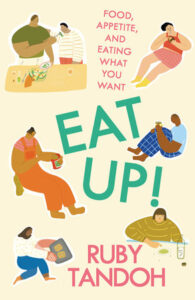When I was eight or nine, my grandmother was living in a house in a sleepy Essex suburb. I often visited her with my younger siblings in tow, and we used to spend much of our stay in the garden. Granny’s garden was her pride and joy, kept as neat as a guardsman’s coat, the grass soft and verdant, shrubs blooming in bright colors. Granny kept order with a pair of garden shears, her eagle eyes, and a tub of slug pellets.
When we went there during the summer, we were as carefully fussed over, preened and pruned as the roses and the rampant buddleia. I would stand in the sun, sipping orange juice and gripping the grass between my bare toes.
What I loved more than this garden, though, was the scrubby track that ran alongside it and out into the wood beyond. The track shrugged up against my grandmother’s house and garden, its nettles, hollyhocks and tangles of thorns running shoulder to shoulder with the neatly coiffed gardenias and chrysanthemums, separated by the thinnest panels of a smart, stained wooden fence. When we walked along this track, I would linger over matted gray tufts of badger fur, an ant’s nest, a pile of horse poo… these things were a thousand times more interesting than Granny’s perennials.
A few hundred yards along this mud trail were the blackberry bushes. They scrambled up the roadside, along fences and over ragged stone walls, thick with thorns and clusters of inky blackberries, some branches hanging low over the track, drooping heavily with fruit.
I don’t think it’s any coincidence that one of my fondest food memories is one with roots spreading far beyond the kitchen table. There is so much more to eating than just eating.
One day, we traipsed along with old ice cream cartons and clustered around these brambles, pulling the fattest, darkest berries from the branch and throwing them, alternately, into our cartons and our mouths.
Picking the perfect blackberry took some practice: the sweetest berries were the softest, and so the most likely to crush in your grip as you pinched them from the stem. You had to be careful, all the while whipping your hands back from the pricks of the thorns. Bright purple, sticky juice muddled with countless tiny cuts and grazes, which would sting hot all the way back home.
Once back from the abundant chaos of blackberrying, we washed our haul, tossed it with apple segments, sugar and cinnamon and covered it with a thick layer of sweet, nutty crumble. We baked the crumble during the heavy, languid hours of the afternoon.
I can’t remember what the crumble tasted like, in the end—whether the blackberries stained the topping with crimson juice, or whether the apples were blandly sweet, crisp or soggy. I have no idea whether we ate it with cream, or custard, or ice cream. What I can remember is the sting of those blackberry thorns, the herbal smell of dirt, juice and sap on my fingertips, and the precious warmth of a berry picked straight from a patch of midday sun.
I don’t think it’s any coincidence that one of my fondest food memories is one with roots spreading far beyond the kitchen table. There is so much more to eating than just eating. Eating is picking blackberries, or deciding to pick blackberries next week, or remembering blackberries you picked fifteen years ago.
It is choosing a mango in the supermarket—one soft enough to hold a dimple when you press a thumb to its flesh—holding it to your nose, and taking a gulp of its heady scent. Eating is texting your housemate “Let’s get takeaway.” It’s weighing up your options between the tarka dal and the Keralan fish stew, and taking the time to squint your eyes, smack your lips and taste-imagine your way to a decision.
Giving food a story means giving a simple meal the power to become a lifelong memory.
Eating is feeding someone else. Eating is toasting spices in a hot pan, folding whisked eggs into a cake batter, slowly cranking the handle of a tin opener around a can of tomato soup. Eating is standing in front of the empty fridge, willing inspiration to come. Eating is folding down every page corner in a new recipe book.
In order to eat well, we need to eat with every part of ourselves. We see, feel, sense, taste, touch, predict and imagine food long before it ever arrives on our fork. Every one of these experiences is a kind of emotional, sensorial aperitif.
Food shows on TV are particularly good at this kind of drawn-out, teasing temptation: watch Nigella Lawson glide around her kitchen and you’ll notice all the exaggerated sensations, from the loudness of cake batter plopping into a tin or an avocado raspingly scraped from its skin, to the shimmering light, rich colors and slow-motion tactility of it all. Ina Garten might take a journey to the deli to choose some lox herself, taking us with her to see the glistening fish and experience the bustle of New York City, then back to the serenity of her country kitchen. The choosing, the sorting, the serving: from this comes a story.
Giving food a story means giving a simple meal the power to become a lifelong memory, whether that story starts with dipping a net in a rock pool or heaving a trolley around the supermarket on a Saturday morning. It’s about engaging all of your senses, and letting food, body, craving and daydream all bleed into one.
But chances are that no matter how blasé you think you are about food, you’re piecing together a web of food stories and sensations every time you go to eat.
I often think about blackberrying and about my juice-stained fingers and that eventual apple and blackberry crumble, and what always hits me is the blurriness of it all: the act of eating stretched out from bramble to plate; juice dying my fingertips blood red; and the smell of cooking crumble, and how these smells—both thick and sweet—became one and the same in my memories of that day.
This is all well and good, of course, until it comes to weaving it into the fabric of ordinary, hectic everyday life. Take the time to cradle a jar of pasta sauce and really feel it in your local supermarket and you’ll be there in aisle 5 all day. Engage all of your senses and smell, taste and touch your way across the candy selection of your local 7-Eleven and it probably won’t end so well.
I got shouted out of a shop in Italy by a nonno once because I didn’t realize that touching the fruit and veg wasn’t the kind of tactile, immersive Italian gesture of food thought-fulness that I thought it was. “I ganti! I ganti!” the grandad hollered after me, while a gaggle of suitably be-gloved women tutted at me from the zucchini.
But chances are that no matter how blasé you think you are about food, you’re piecing together a web of food stories and sensations every time you go to eat. Raising a glass with your mates, closing out the ruckus of the pub around you and bringing the dishwasher-warm pint glass to your lips for the first sip of beer: this is a food ritual. It turns a lukewarm pint into some kind of rousing, fortifying nectar.
Choosing the fullest-looking cheese and ham sandwich from Pret A Manger, or eating an Oreo just so—these are the things that make food so much more than just fuel. We use our imaginations to bring new life to the saddest slice of lunchmeat, reviving it with some sharp pickle and good bread. We play with our food. We use every one of our senses. When the moment comes to finally eat, we taste more clearly than ever.
_________________________________

Adapted from: Eat Up! by Ruby Tandoh. Copyright © 2018, 2022 by Ruby Tandoh. Published by arrangement with Vintage Books, an imprint of The Knopf Doubleday Group, a division of Penguin Random House LLC
